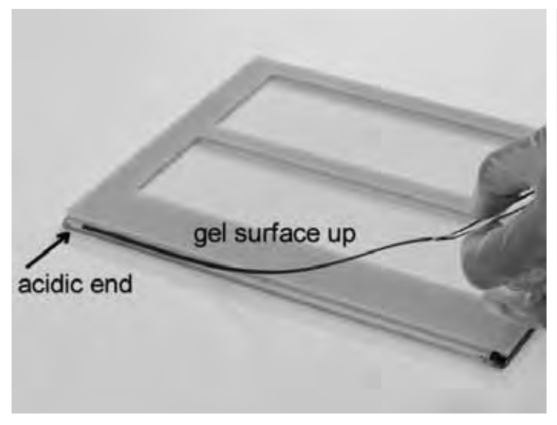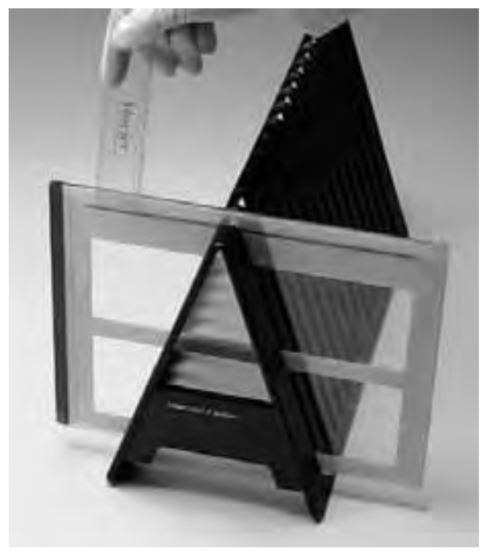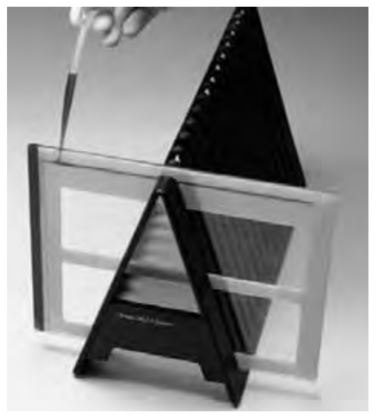Applying Equilibrated Immobiline® DryStrip Gels to SDS Gels
Both types of DALT gel cassettes (those for precast and for lab-cast gels) have a “longer” glass plate. The cassette should be laid on the bench with the longer glass plate down, and the protruding edge oriented toward the operator (Figure 39).
Protocol
1. Position the Immobiline® DryStrip gel
Dip the equilibrated Immobiline® DryStrip gel (section 3.1.2) in the SDS electrophoresis buffer (see appendix I, Solutions, solution M) to lubricate it. If using the DALT Gel 12.5, the diluted cathode buffer can be used to lubricate the strip. Place the strip with the acidic end to the left, gel surface up onto the protruding edge of the longer glass plate (Figure 39). If using a system other than DALTtwelve or DALTsix, position the Immobiline® DryStrip gel between the plates on the surface of the second-dimension gel with the plastic backing against one of the glass plates.
2. Ensure Immobiline® DryStrip gel has good contact
With a thin plastic ruler, gently push the Immobiline® DryStrip gel down so that the entire lower edge of the Immobiline® DryStrip gel is in contact with the top surface of the slab gel (Figure 40). Ensure that no air bubbles are trapped between the Immobiline® DryStrip gel and the slab gel surface or between the gel backing and the glass plate.
3. Optional: Apply molecular weight marker proteins
Best results are obtained when the molecular weight marker protein solution is mixed with an equal volume of a hot 1% agarose solution prior to application to the IEF sample application piece. The resultant 0.5% agarose will gel and prevent the marker proteins from diffusing laterally prior to the application of electric current.
Other alternatives are to apply the markers to a paper IEF sample application piece in a volume of 15–20 µL. For less volume, cut the sample application piece proportionally. Place the IEF application piece on a glass plate and pipette the marker solution onto it, then pick up the application piece with forceps and apply to the top surface of the gel next to one end of the Immobiline® DryStrip gel. The markers should contain 200–1000 ng of each component for Coomassie staining and approximately 10–50 ng of each component for silver staining.
4. Seal the Immobiline® DryStrip gel in place
The agarose sealing solution prevents the Immobiline® DryStrip gel from moving or floating in the electrophoresis buffer. For precast DALT gels, the agarose blocks the narrow gap(s) between the gel edge(s) and the lateral spacer(s) to prevent leakage of the upper buffer.
Prepare agarose sealing solution for DALT precast gels using the agarose sealing solution from the DALT Buffer Kit. If using the Laemmli buffer system, see appendix I, solution N (Solutions).
Melt each aliquot as needed in a 100 °C heat block (each gel will require 1–1.5 mL). It takes approximately 10 min to fully melt the agarose.
An ideal time to carry out this step is during Immobiline® DryStrip gel equilibration.
Allow the agarose to cool until the tube can be held with your fingers (60 °C) and then slowly pipette the amount required to seal the Immobiline® DryStrip gel in place (Figure 41). Pipette slowly to avoid introducing bubbles. Apply only the minimum quantity of agarose sealing solution required to cover the Immobiline® DryStrip gel. Allow a minimum of 1 min for the agarose to cool and solidify.

Figure 39.Positioning an equilibrated Immobiline® DryStrip gel on the DALT Precast Gel Cassette

Figure 40.Pushing the Immobiline® DryStrip gel down to contact the gel slab.

Figure 41.Sealing the Immobiline® DryStrip gel in place on a DALT precast gel using agarose sealing solution.
Materials
如要继续阅读,请登录或创建帐户。
暂无帐户?